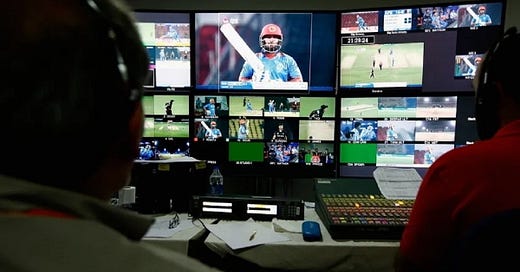The financial future of South African cricket has been perilous for years as its cash reserves didn’t so much dwindle away as gush in a torrent of waste and mismanagement, so perhaps it should be no surprise that the silver bullet solution – the SA20 – isn’t finding things easy.
Details, of which there are many, aren’t the issue for the purposes of explaining the problem. The SA20 cannot succeed unless it is broadcast in India. The deadline for submissions of tender for Indian broadcasters was on Wednesday, October 12. None, apparently, submitted a bid.
Given that all six Franchises in the SA20 are owned by IPL Franchises, and that the aim of the new league is, in time, to include Indian players, all be they young, uncapped stars, it is irrefutably correct to assume that the SA20 would be a desirable product for the Indian market. And that one of the four or five major broadcast networks would bid for the rights to televise it.
Equally, the networks are aware that the SA20 (and Cricket South Africa) are not merely inconvenienced by the lack of a broadcast partner in India, but critically hamstrung. Fatally injured, in all probability. They may be able to limp through the first season but thereafter the funds would dry up and the project would be doomed. Along with the Global League T20 and the Mzansi Super League. And the professional game in South Africa.
The SA20 board was advised by their rights brokers to charge $240k per SA20 game ($8million per season) with a 5% annual increase for 10 years. And to ‘bundle’ the SA international fixture rights into the deal, at a separate cost. It would increase the annual revenue and keep the deal clean and easier to manage.
But the Indian broadcast corporations, despite their fierce rivalry, appear to have formed a kraal. At least one of them has been ‘leaking’ all of the correspondence from the SA20 straight to the media, with their (uncredited and unattributed) interpretations. SA20 and CSA spokespeople have, thus far, continued to assert that such negotiations are, and should remain, private and confidential.
There are two scenarios, or perhaps a combination of both. SA20 has over-priced its product to such an extent that even India’s fiercely competitive broadcast networks have agreed to stand firm in brief solidarity. Or that the networks, all interested in the product, have temporarily agreed to work together to drive the price down before the free-for-all scramble to claim the prize when the starting price is right. The way that wolves hunt as a pack.
A while ago I wrote about why Temba Bavuma and Andile Phehlukwayo went unsold at the SA20 Player Auction. There was plenty of on-field, statistical evidence for their non-sale, but the word from the auction floor was that their base price of R850k was the overwhelming reason they weren’t bought. If somebody, or something, is valued at 10, there may be a purchaser willing to pay 100. But if that same person, or thing, is valued at 50 then nobody is interested. Right now, the SA20 board will be hoping that they, too, haven’t over-estimated the market’s desire for their services.
Perhaps the SA20 board and their advisors have got it wrong, over-estimated their value. Tom Harrison, the former England Cricket Board chief executive, is the special financial advisor. His dispassionate independence may be an asset on one hand, but with no skin in the South African game he may have been less likely to exercise caution with the numbers.
All six of the SA20 franchises have been asked to make a commitment to developing the game in their region of the country although there are no specific requirements. All six have stated publicly that they are in the tournament for the ‘long run’ and don’t expect to make a profit “for many years to come” in the words of Royals CEO, Jake Lush McCrum.
The truth is they will never make a cent unless the tournament is televised in India by one of the major networks. The exposure provided to their Franchise brand and their associated sponsors by expansion into the Caribbean Premier League, the (UAE-based) International League T20 and the SA20 will never provide more than 10% of their corporate income. The vast majority will always come from the IPL. Their involvement in South Africa cannot, and will not, go ahead without an Indian broadcast partner.
When Haroon Lorgat was running the ill-fated Global League T20 he was so convinced that an Indian broadcaster would eventually blink and make an offer that he waited until six weeks before the first game – at which CSA lost its nerve and cancelled the tournament at a loss of over R200 million.
It is inconceivable that a deal won’t be done this time unless both sides become intransigently stubborn and it becomes about egos. That isn’t going to happen with the SA20 board of directors – there is too much at stake. League Commissioner, Graeme Smith, is the most powerful and influential South African in cricket and enjoys enormous respect in India. For the last fortnight he has been working on the biggest deal he will ever do in his life. He always got the job done on the field, and he’ll get it done in the boardroom. The game is depending on him.





Has CSA been bundled out?
The issue seems to be with the huge increase in the SA-India games (for Indian tours), and the bundling, which means you only get the good-value SA20 (at 8mil per season) if you will pay the seemingly over-the-top prices for SA's home games for the next 10 years (which doesn't include India's tour in 2023/24, and only 1 other confirmed India tour in that period?)